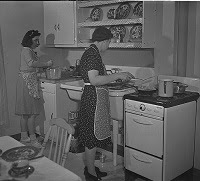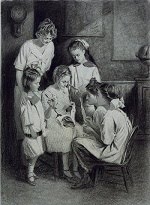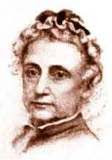
Teaching Mental Math Skills
I am going to share a couple of ideas with you. These are things I have done for many years with my own children. In Part One, I shared about how I used the 1800’s McGuffey Readers. In Part Two, I shared how to teach your student to enjoy editing and proofreading.
In Part Three I explained how to develop fun writing ideas for your students. We use nothing more than a notebook, pen and a dictionary.
In this section, I will describe how I used the 1800's Ray's Arithmetic books along with a 1934 textbook, Stayer-Upton Practical Arithmetic to teach my children mental math skills. I will also give you some ideas how to do this in your own homes.
Ready?
We will start with Rays Arithmetic Series (8 Volume Set)
[This set of books was published by Mott Media, and is reprinted from the 1800's version used in one-room schoolhouses.]
Have you ever seen episodes of Little House on the Prairie, where the student can quickly solve a math problem? It amazes me every time! What I am going to describe for you today, is the beginning steps of teaching fast mental math skills to your students.
We will use the first book in the series, Primary Arithmetic.
1. For young students: Give them pennies or an abacus. Do one or two pages, from the book, each day. The child should sit at a desk or table. You, as the teacher, will say each problem and have the child use the manipulatives to come up with an answer.
2. For older students: The child should have a paper and pencil handy for scrap paper, if needed. You should do one to three pages each day. Simply go through each problem asking each question and waiting for an answer. Do this as quickly as you can. If the child does not hear you, or needs to hear the problem again, tell him to simply say "repeat." This makes the process quick and efficient.
Here are some examples of what you will find in this book:
1. One from 7 leaves how many? Two from 7? Three from 7? Four from 7? (page 10)
2. I bought a kite for 9 cents, and sold it for 18 cents: How much did I make? (page 36)
3. When pears are 4 cents each, how many can you buy for 12 cents? (page 58)
4. How many are 19 + 1? 2+19? 19+3? 4+19? 19+5? 6+19? (page 70)
If these are systematically done quickly, a little each day, their problem solving and memorization skills will soar. Continue with this method using the other books in the set.
Here are some examples you will find in the next book in the Ray's Series, Intellectual Arithmetic. This is for older students: [The child will need paper and pencil for this.]
1. George bought a book for 50 cents and sold it for $1: what would he have made had he bought 2 books, and sold them at the same rate as the first? (Page 34)
2. If a man earn $15 per week, and spend $11 a week, how much will he save in 3 weeks? How much can he save in 8 weeks? (page 35)
In the above examples, the child will need to take apart the questions to solve the problems. (Excellent analytical skills will be acquired from this.)
Here are more examples from this book:
3. If an apple is worth 3 cents, what is 1/3 of the apple worth?
4. What are 3/4 of 20?
5. What are 2/5 of 15? 3/5 of 20? 4/5 of 25?
You can see from the above examples that your student will learn to solve problems very quickly.
If you work for about 15 minutes on this, each school day, your child will learn to think quickly.

Let's move on to some major fun with
Practical Arithmetics Book 1
This book was published in 1934 by George D. Strayer and Clifford B. Upton. It is currently available through CBD. It has been described as an Amish Textbook by the current publisher. I believe it is commonly used in Amish schools. Now, understand that the Amish educate their children through the 8th grade only, but they receive an excellent education in a short amount of time.
Here's the fun you can have with this book:
You will find pages- upon- pages of math drills. Anything from simple arithmetic, to simple division.
I came up with a "game" to use with my children.
1. On page 375, you will see the following problem:
9 + 3 + 7 + 0 + 6 + 3 =
Here is what you can do. Don't allow your older students to use paper to solve this. It is a mental math drill. Say the above problem exactly as it is written. Then have your students (one or more), write down the answer only. Quickly check to see that it is correct.
Move on to the next problem. Do as many as the children want. It is a lot of fun for them. We often do 10 or so at once. But we do them very, very quickly. Amy (15) and Matthew (17) are so fast at this, I cannot even solve the problems as quickly as they can. As a matter of fact, I sit there with a calculator to make sure they are right. (smiles)
2. Try this problem:
485 + 894 + 689 + 320 + 490 + 194 + 884 =
If you say these numbers in a steady, careful manner, the children will learn to recall what you say and write them down without having you repeat any of them. Here is an example of how I would say this, "Four hundred eighty five... plus.... eight hundred ninety four... plus.. etc." This gives them enough time to process the information. They will need to write these down on a piece of paper.. . Then solve the problem. . . Then show you their answer. [Make sure the child knows to say "repeat" just in case they didn't get it the first time.]
If they get it right, great! (I often just nod my head, smile and move on.) If they get it wrong, have them try again. If they are still wrong, check their numbers to be sure they copied them correctly. Or you may find they made a simple math error somewhere and can help them resolve it.
Here are some important tips:
1. Never have children work together who are on different levels. For example: A 7 year old should not compete with a more experienced 14 year old. They will only get upset and fight.
2. Keep things moving along very quickly. This helps them develop speed in solving math problems.
3. At any time, if your student gets grumpy, tired or frustrated. Stop. Praise him and take a break.
How long does this take? About 15 minutes each day.
What will your student learn? 1. Memorization skills. 2. Fast thinking. 3. Problem solving.
What does Mom have to know in order to do this? Not much. (Smiles) She simply uses the answer key and a calculator and she is all set!
Enjoy your math time!!
Blessings,
Mrs. White
- To find out more about this blog, or Mrs. White, please visit our About page. -





































4 comments:
Thank you SO MUCH for sharing this! I started using Ray's with my nine- and five-year-olds back in January. At first, I was doing Ray's two days a week and Math U See (the curriculum we've always used before) three days a week. About a week ago, I started wondering if I should just switch to Ray's full time ... I've wondered, though, if I can teach the higher math as successfully with Ray's as I could with Math U See. Part of me thinks, "Of course!" and part thinks, "I don't know!" It's encouraging to hear how you've used Ray's (and Practical Arithmetics) through high school.
So glad you found it helpful, Cindy!
Blessings,
Mrs. White
Guess what I got today, I recieved my bakeware. I am going to make cookies or homemade pizza this weekend and blog about it. Thank you so much again.
Mrs. White,
I have loved this series you have been writing! Thank you for writing these and sharing these nuggets with us! I have been blessed!
Thank you!
Jennifer S from the Crew
Post a Comment